Bathed in sunshine and layered with textural, time-worn details, a farmhouse sunroom invites the outdoors in while remaining cozy year-round. Current design pros highlight three constants: authentic materials (reclaimed wood, brick, wicker), flexible transitions (sliders, French or barn doors) that open to patios or gardens, and décor that changes easily with the season. The 20 ideas below weave those principles into practical, room-ready concepts—each one crafted to help you boost natural light, improve comfort, and add soul to your own sun-kissed retreat.
1. Rustic Wood-Beam Sunroom Charm
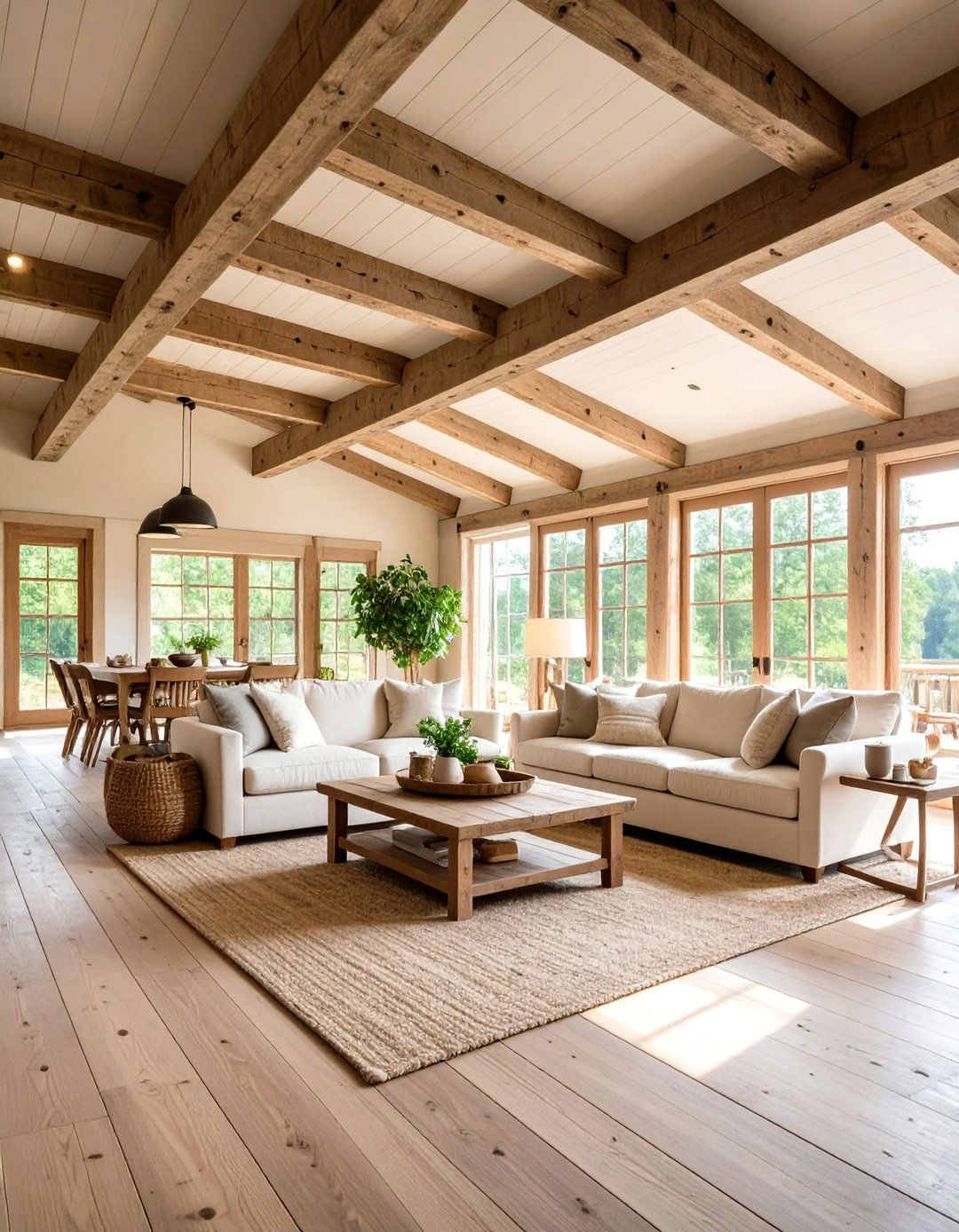
A weathered ceiling beam immediately grounds a farmhouse sunroom in rustic authenticity, drawing the eye upward and emphasizing architecture you already own—or can add with affordable faux beams. Start by sanding reclaimed lumber, then seal it for humidity resistance. Pair the beams with pale walls so the warm grain stands out, and install hidden uplights along the joists for a glow after dark. Mixing beams with fresh white paint keeps the space feeling airy rather than heavy, a balance designers recommend when marrying farmhouse roughness and sunroom brightness.
2. Whitewashed Shiplap Walls for Subtle Texture
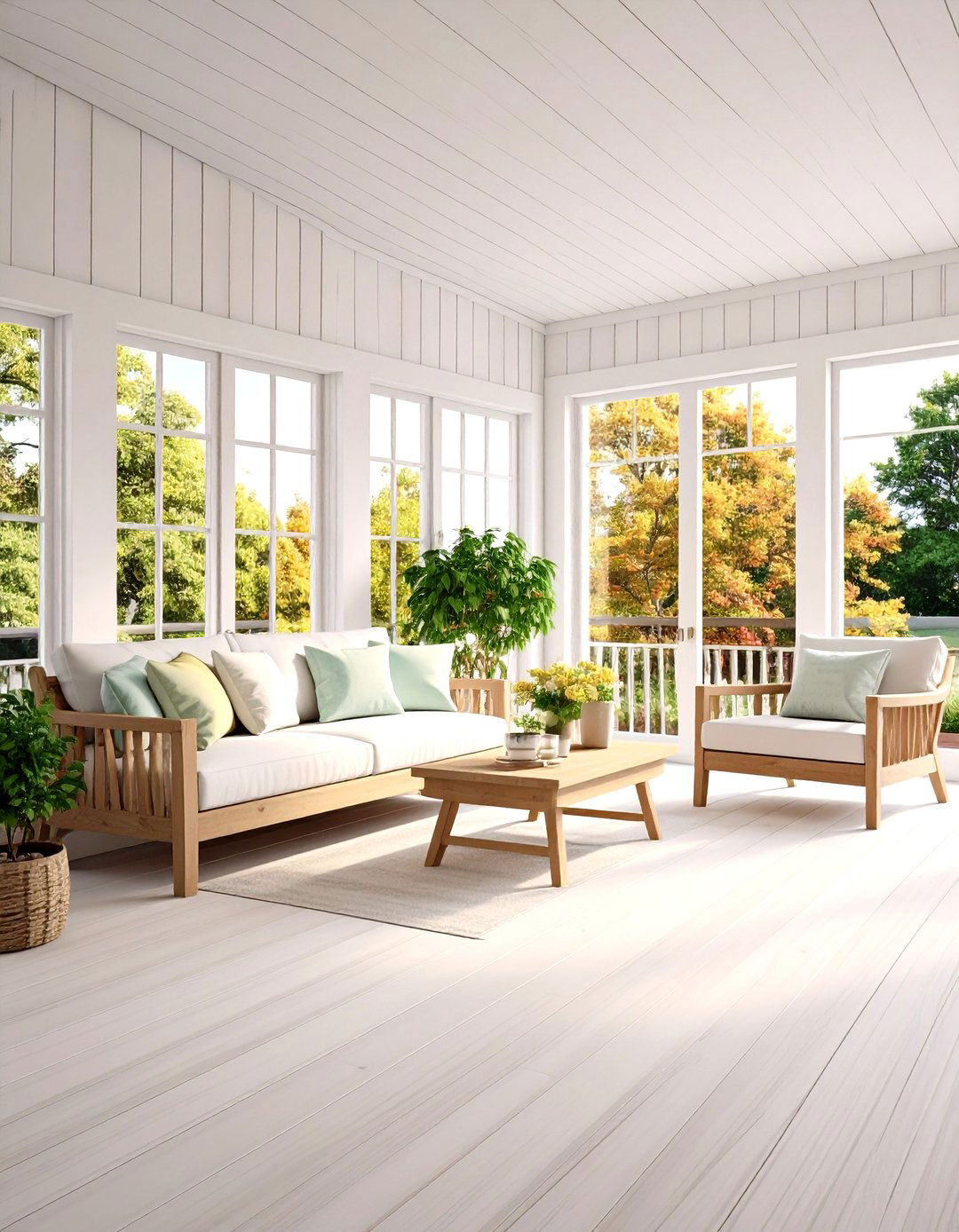
Whitewashed shiplap instantly brightens a sunroom while supplying the subtle shadow lines that give old farmhouses their depth. Opt for nickel-gap boards to create crisp, even reveals, then finish them in a durable, washable matte so fingerprints wipe away. The horizontal planks visually widen a narrow sunroom, and their light tone bounces daylight deeper into the house. To keep the look cohesive, carry shiplap onto any knee walls or built-in benches and echo the linear motif in simple Roman shades.
3. Vintage Wicker Seating Nods to Porch Heritage
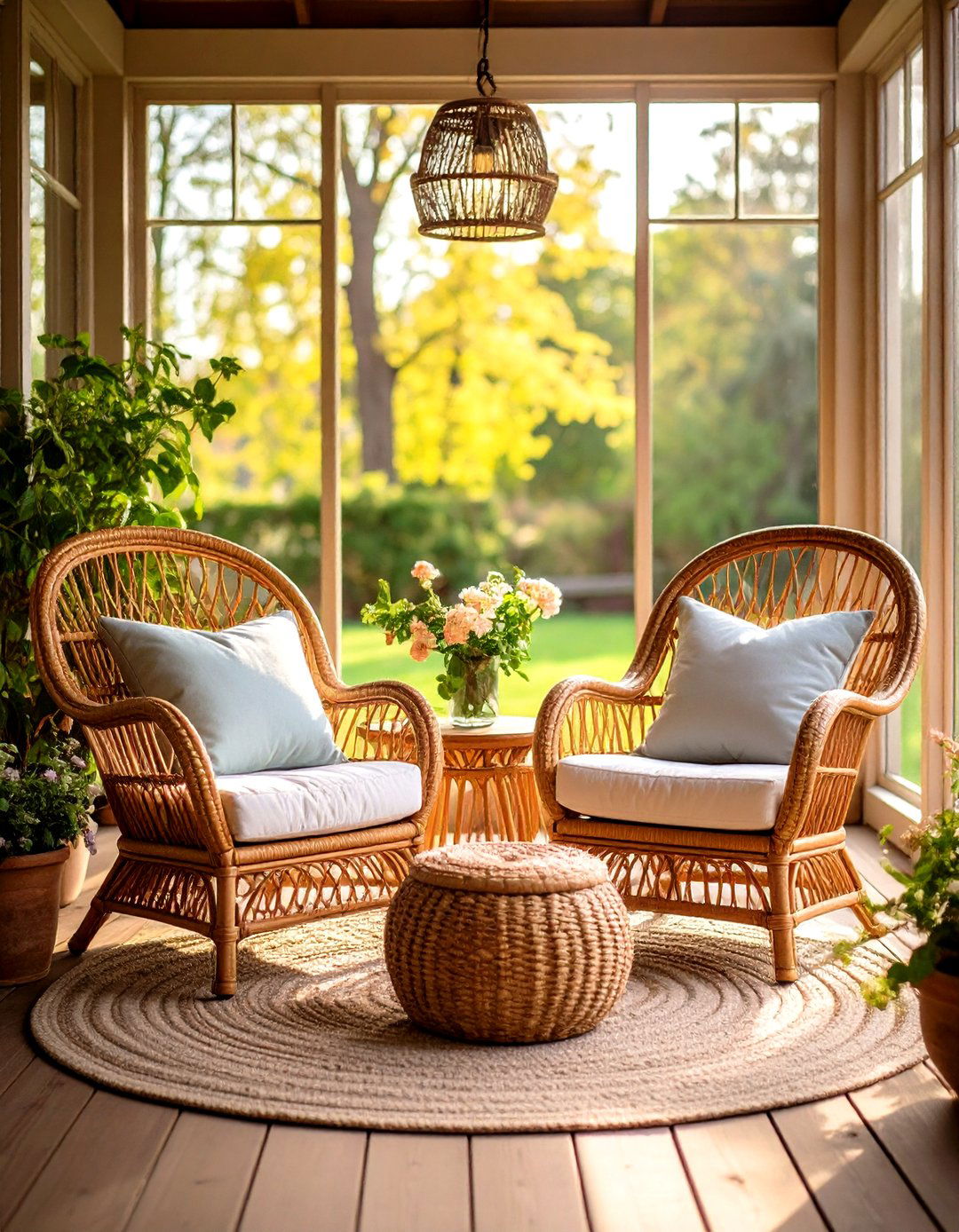
Nothing whispers “lazy afternoon” like a pair of high-back wicker armchairs flanking a low ottoman. Seek out vintage frames—they’re sturdier and age to a soft honey tone—and refresh them with UV-resistant cushions in a faded ticking stripe. Lightweight wicker lets you rearrange seating with the seasons: group chairs around a coffee table for game night, then rotate them toward windows when blooms arrive. The inherent airflow of woven cane also keeps summer lounging cool.
4. Oversized Sliding Barn Doors for Indoor–Outdoor Flow
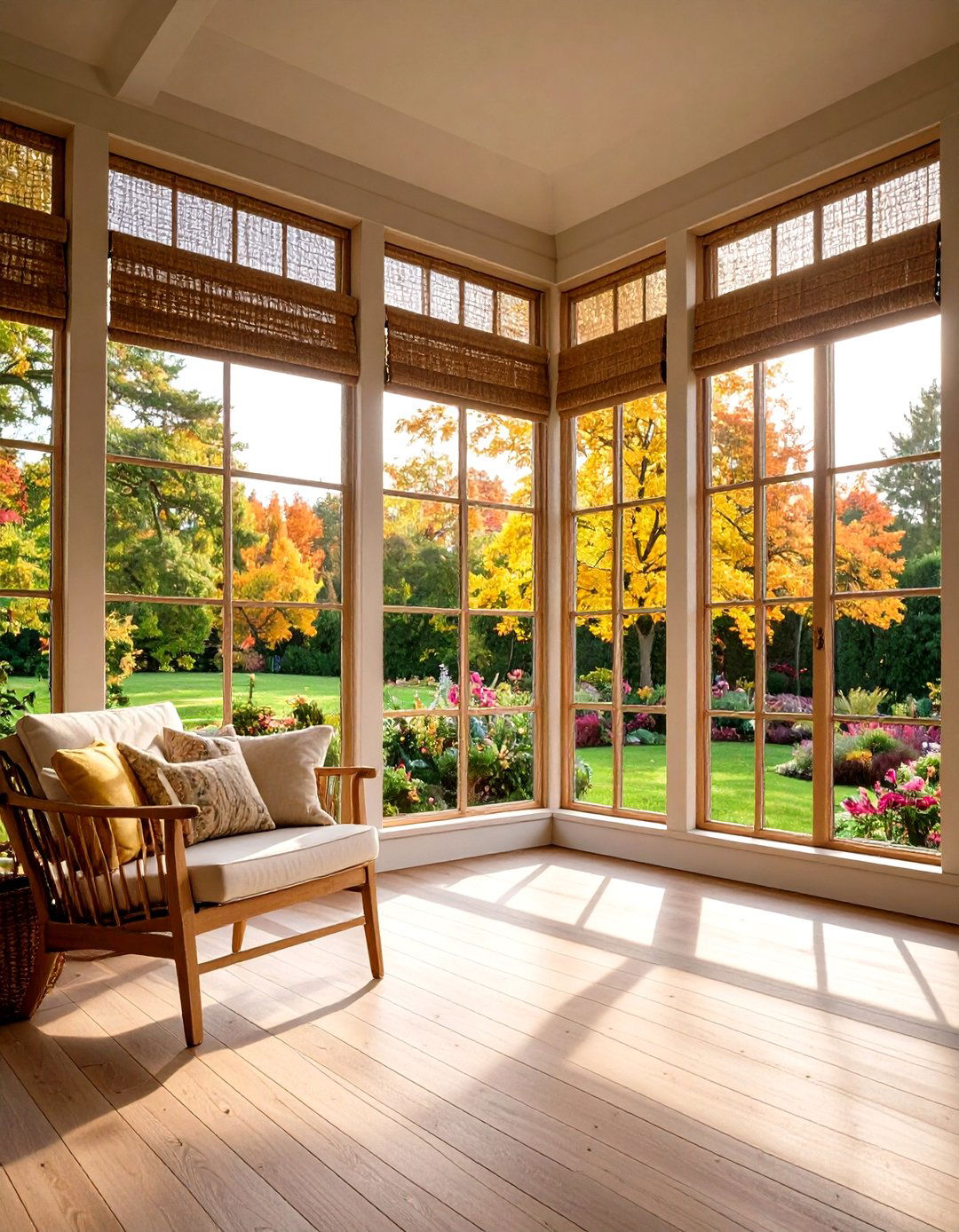
Swapping a standard doorway for sliding barn doors grants a farmhouse sunroom bold character and uninterrupted sightlines. Choose a plank-style slab in lightly distressed pine and mount it on a quiet soft-close track so breezes won’t bang it shut. When open, the broad opening merges sunroom and living area; closed, it buffers drafts without sacrificing style. Designers warn that barn doors lack full acoustic privacy, so position them where noise control is less critical—think breakfast nooks over bedrooms.
5. Mixed-Metal Lighting for Collected Appeal
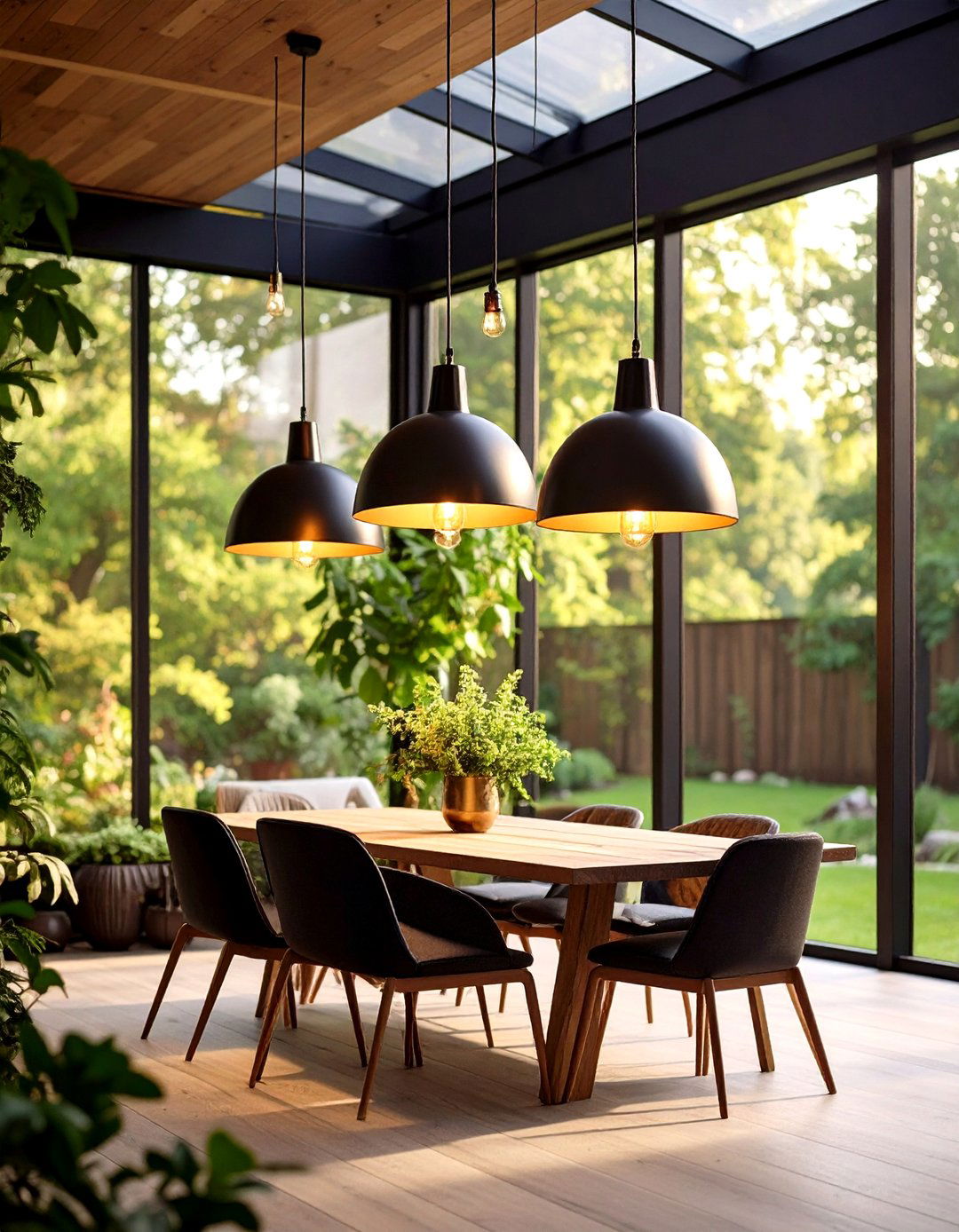
Layered lighting lets a sunroom flex from morning lounge to evening cocktail spot. A black-and-brass pendant overhead pairs gracefully with aged-copper sconces, proving that metal finishes don’t have to match to feel intentional. Anchor the palette by repeating one tone—perhaps antiqued brass—on window fasteners or picture frames, then use complementary shades elsewhere. Warm LEDs (2700 K) flatter the natural patina of wood and wicker while preventing the space from skewing too cool after sunset.
6. Wraparound Panoramic Windows Celebrate the View
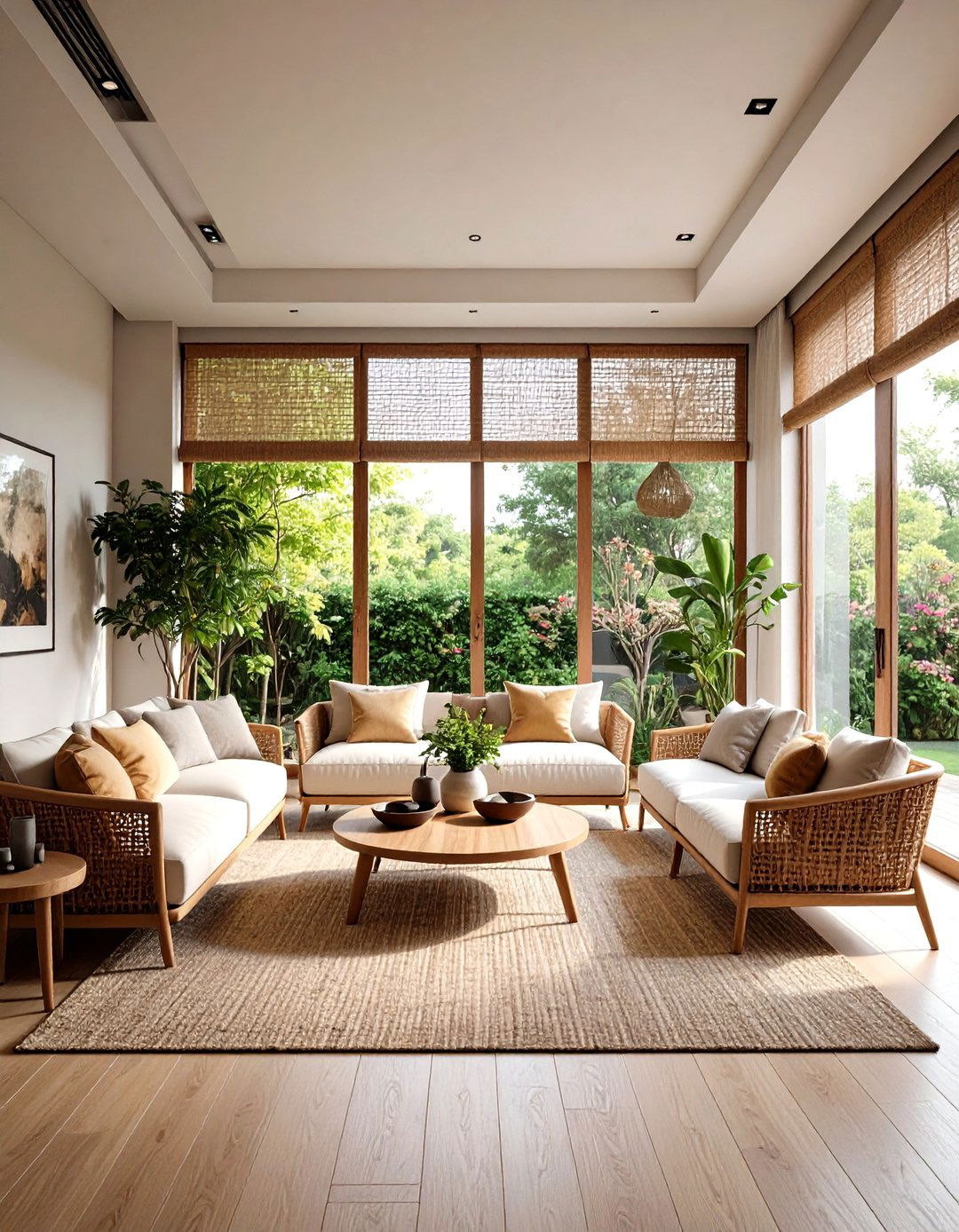
If you’re planning a build-out, allocate budget to floor-to-ceiling windows on at least two sides; the investment yields year-round daylight and an unbroken garden vista. Retrofit projects can mimic the feel with transoms stacked above existing sashes or by replacing solid pony walls with tempered glass panels. Keep trim profiles slim to avoid visual clutter, and add woven matchstick shades for glare control that still filters green hues indoors.
7. Stone Hearth as a Four-Season Focal Point
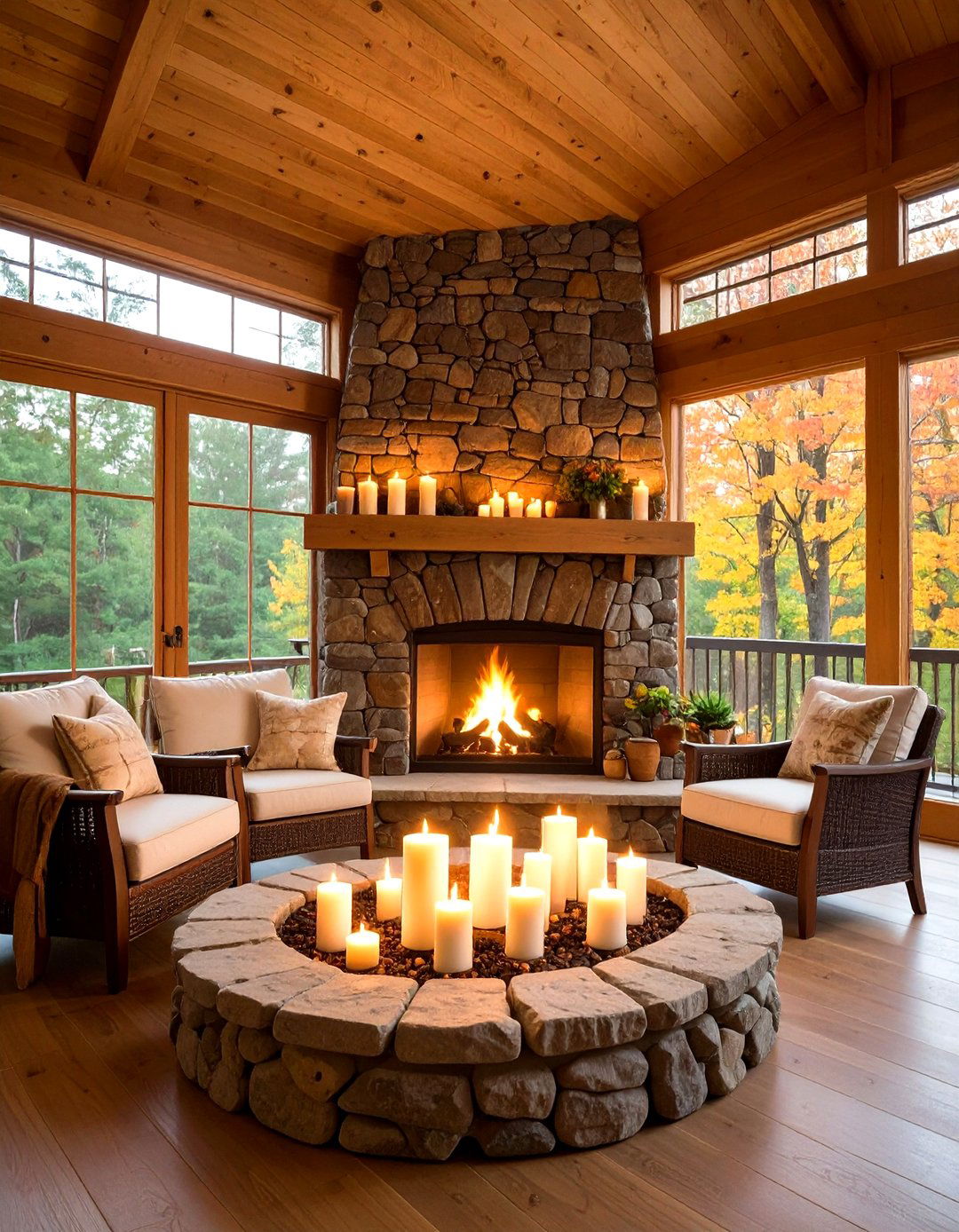
A low, field-stone hearth anchors lounging furniture and extends usability into chilly months. Opt for a vent-free gas insert if venting isn’t practical, or stack oversized pillar candles inside a salvaged firebox for ambience without heat. Continue the stone onto a stub wall to frame built-in shelving where board games and knit throws live. Contrasting the hearth’s rugged texture with crisp shiplap amplifies that signature farmhouse tension between rough and refined.
8. Reclaimed Brick Flooring Adds Texture Underfoot
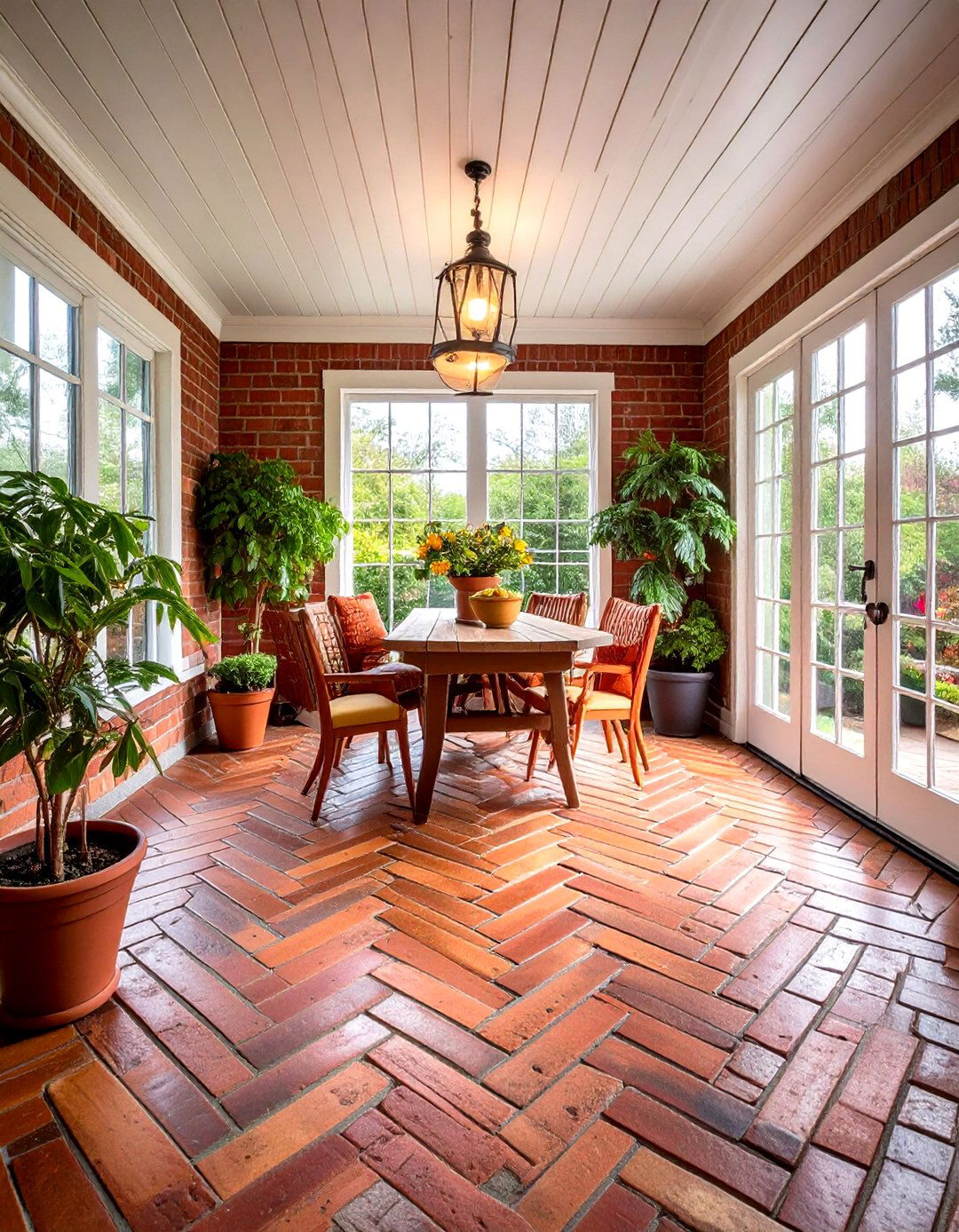
Durable, fade-proof brick tile laid in a herringbone pattern lends instant age and handles muddy boots with ease. Seal the surface in a breathable matte to resist stains while letting natural color variations peek through. Designers often balance brick’s visual weight with airy wall colors and sisal rugs, ensuring the floor reads like a historical feature, not a dark pit. If radiant heat tubing sits beneath, the masonry will store solar warmth and release it after sundown.
9. Indoor Herb Garden Nook for Fresh Flavor
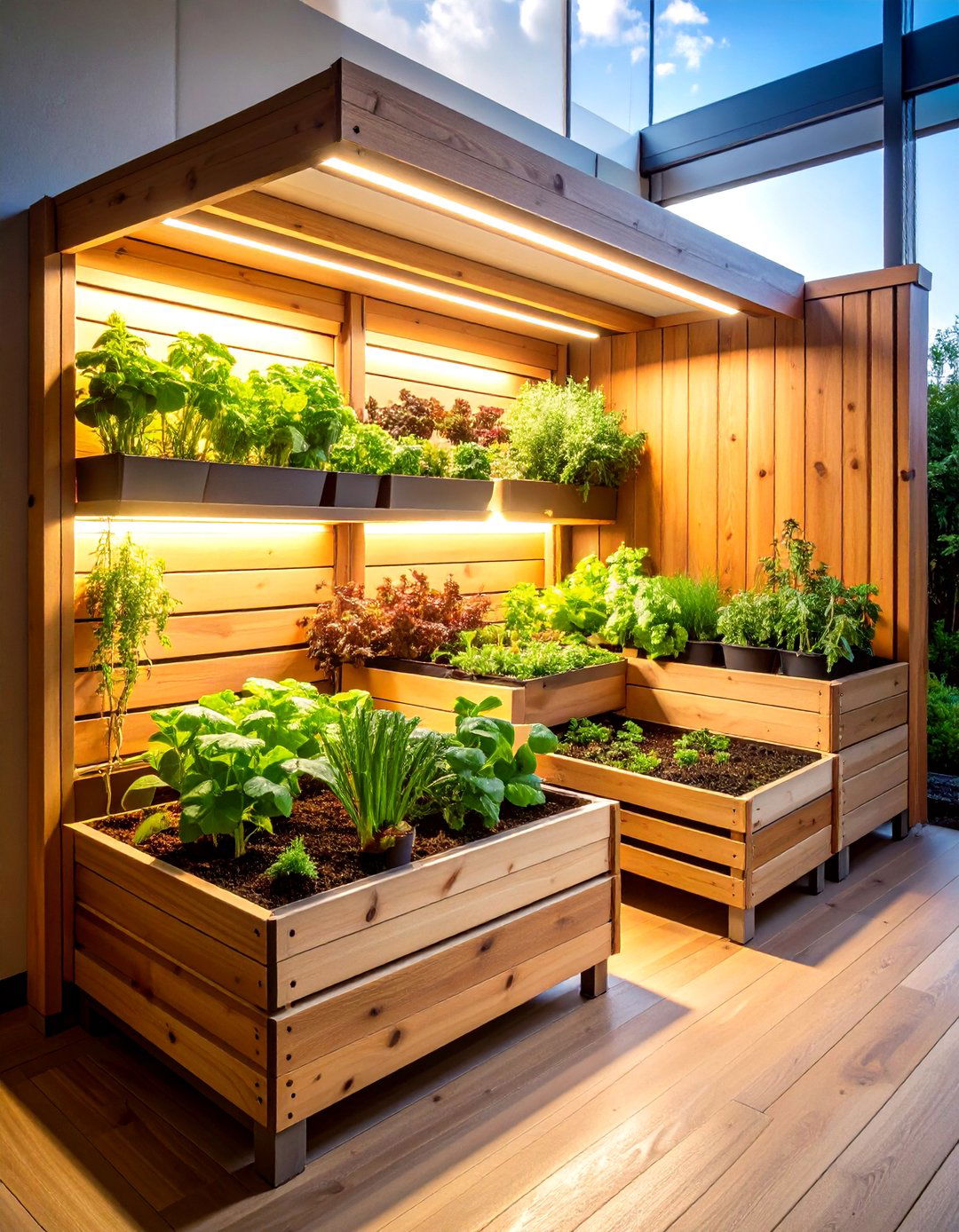
Carve a sunny corner for an herb shelf system: three staggered planks with drainage trays and grow-light strips mounted beneath each tier. Basil, thyme, and mint thrive in the 50–60 % humidity common to glazed sunrooms, provided airflow circulates. A small USB fan and weekly misting stave off fungal issues. Harvesting snips add fragrance to the room and keep plants compact. Bonus: guests love plucking fresh sprigs for iced tea without stepping outdoors.
10. Layered Neutral Textiles for All-Season Comfort
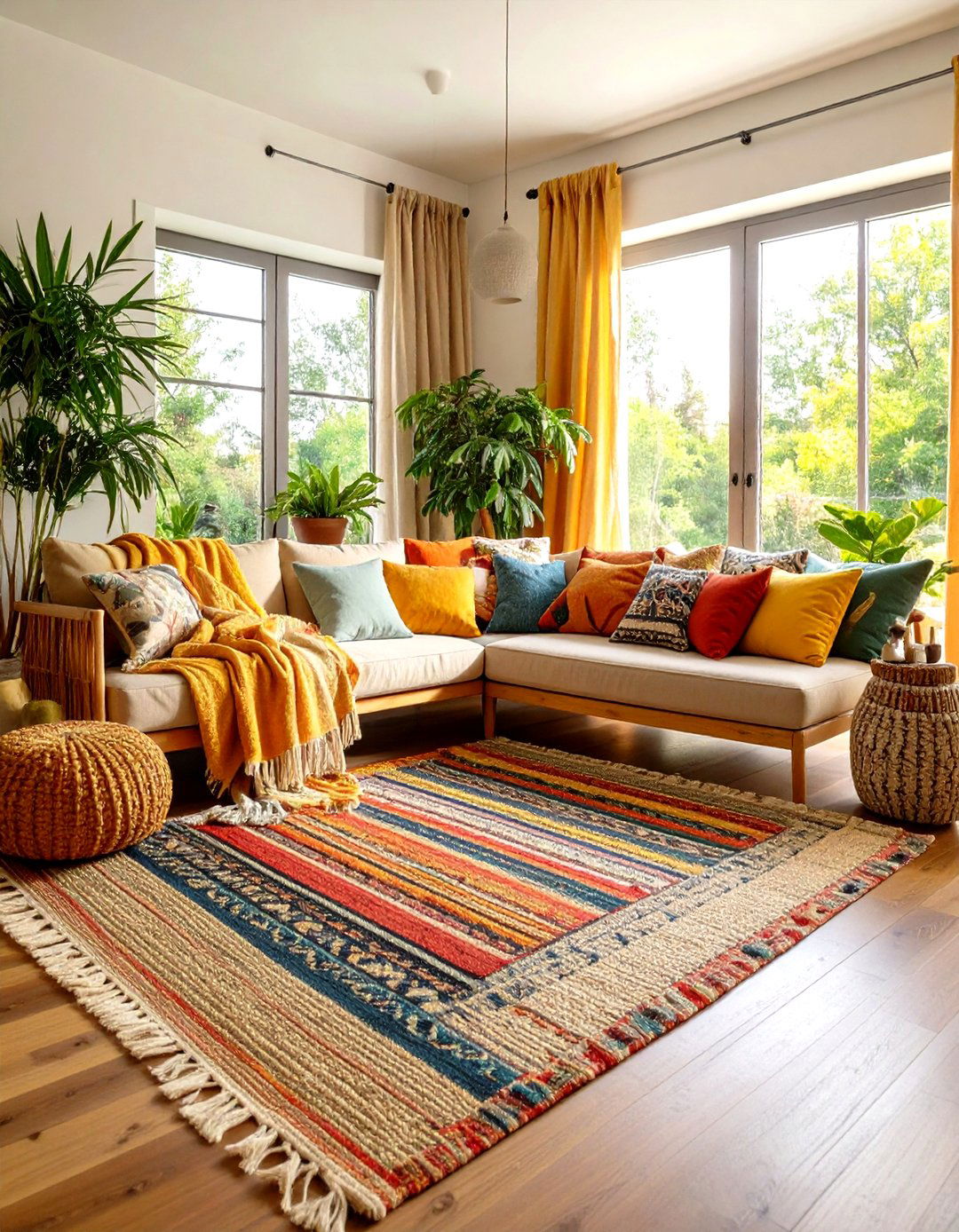
Start with a jute area rug to define the seating zone, layer a cotton kilim for pattern, and finish with a wool throw that echoes pillow stripes—three tiers that read cohesive yet never heavy. Choosing a palette of oatmeal, ivory, and soft gray prevents sun-fade woes common with bold hues. Stash lightweight linen covers in a woven basket so you can swap textures as temperatures shift, maintaining tactile interest without overcrowding storage.
11. Salvaged French Doors Enhance Historic Character
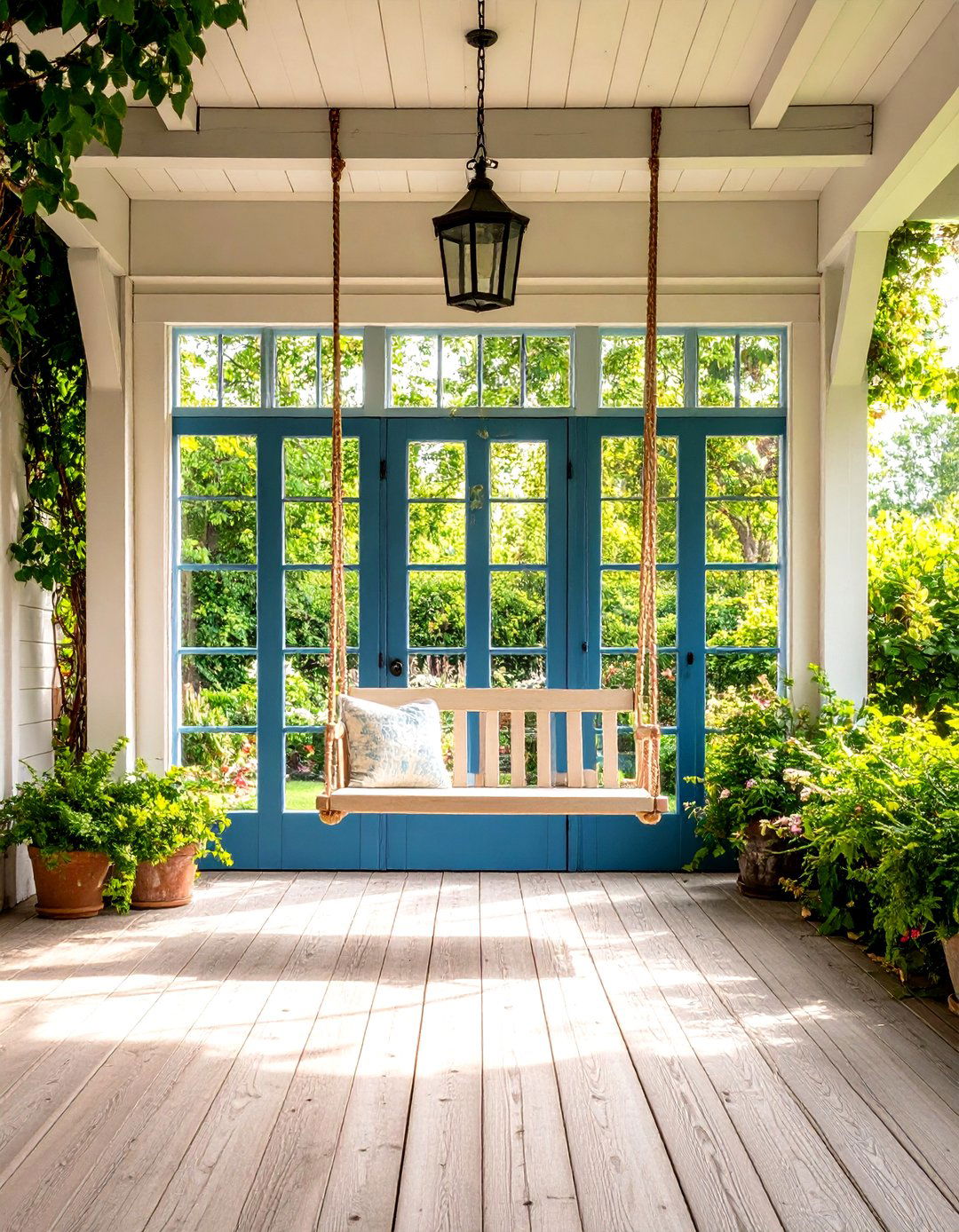
Replacing one wall of fixed glazing with gently aged French doors grants ventilation and period charm. Look for solid-wood units at architectural-salvage yards; reglaze with low-E panes to improve efficiency. Painting the muntins in soft black frames outdoor foliage like artwork, while classic lever handles add tactile pleasure. The double doors’ generous swing also simplifies moving potted citrus trees inside before frost hits.
12. Cozy Reading Corner Tucked Beneath Windows
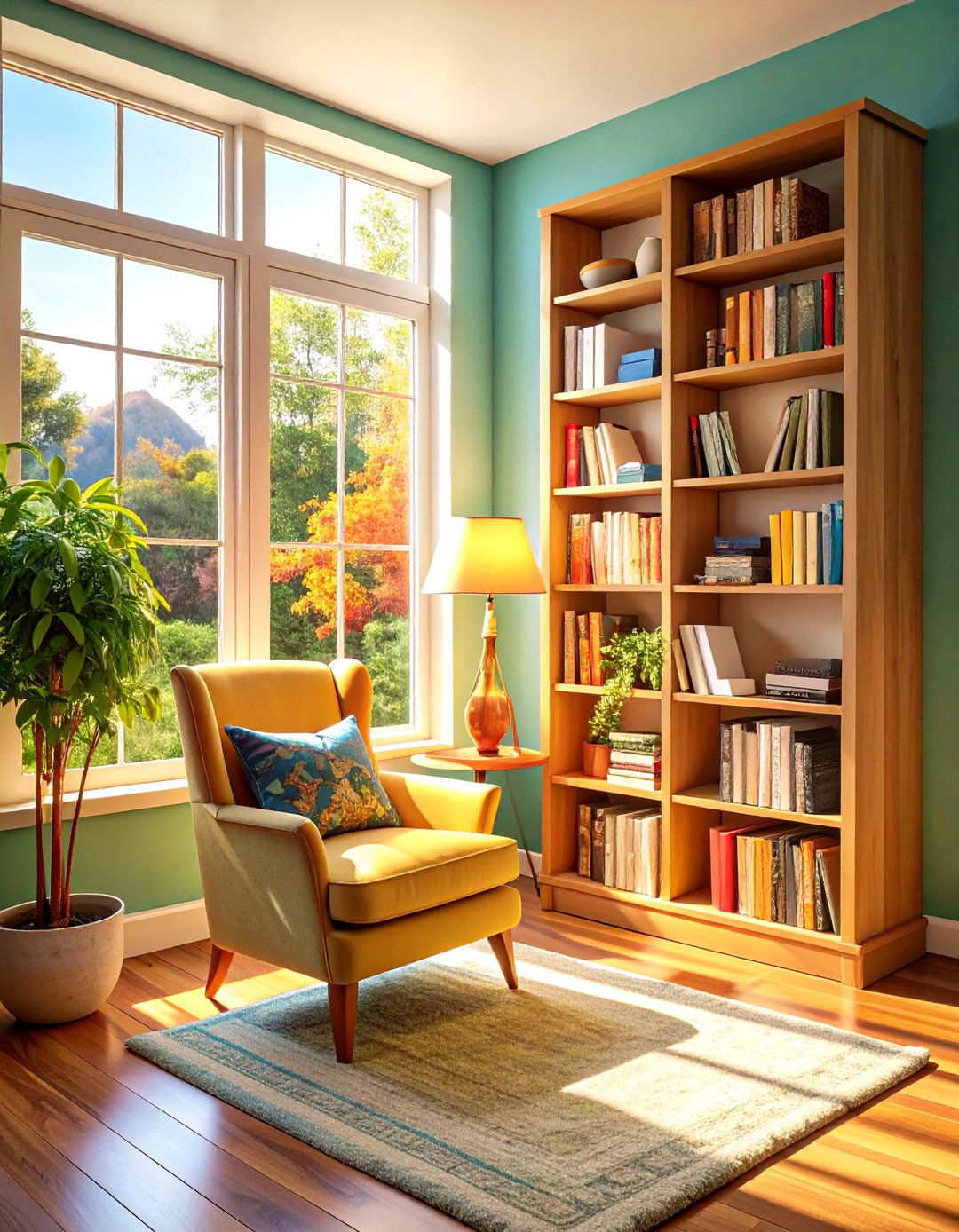
Create an intimate alcove by floating a slipcovered chair perpendicular to glazing and positioning a slim étagère behind it—books stay handy yet catch minimal glare. A swing-arm wall lamp frees floor space and reduces cords, while a small drum table corrals tea and spectacles. Rotate the chair seasonally so you’re never staring straight into the sun, ensuring the nook remains comfortable from dawn essays to twilight novellas.
13. Lofted Cathedral Ceiling Elevates Airiness
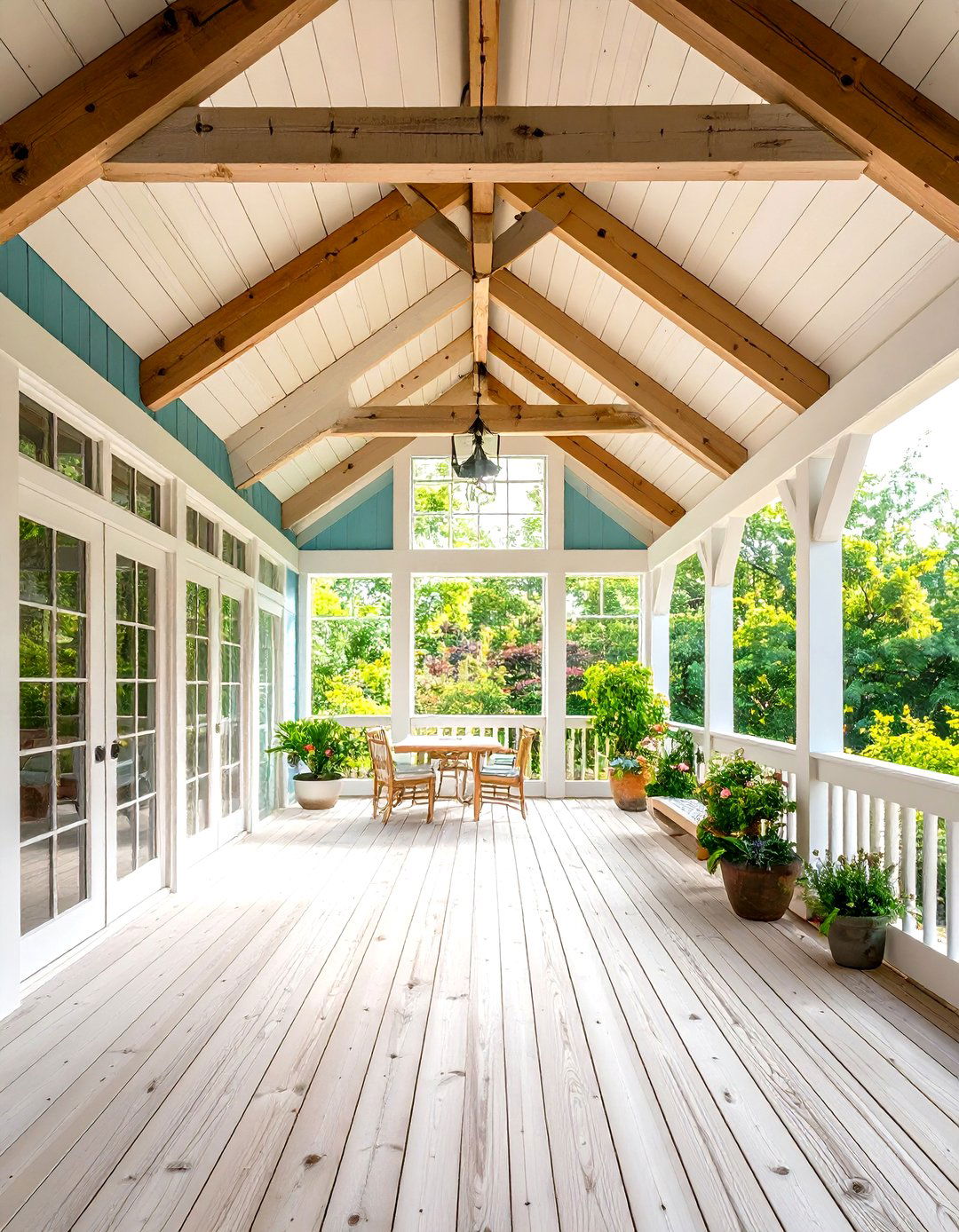
Where structure permits, punch the ceiling upward to reveal original rafters, then paint decking boards a soft white so beams pop. Designers note that raising sightlines by even 18 inches dramatically increases perceived square footage and encourages warm air to stratify above seating. Add a remote-controlled fan to pull heat down on cool evenings and to keep breezes circulating through open transoms in midsummer.
14. Pastel Accent Palette for Gentle Color
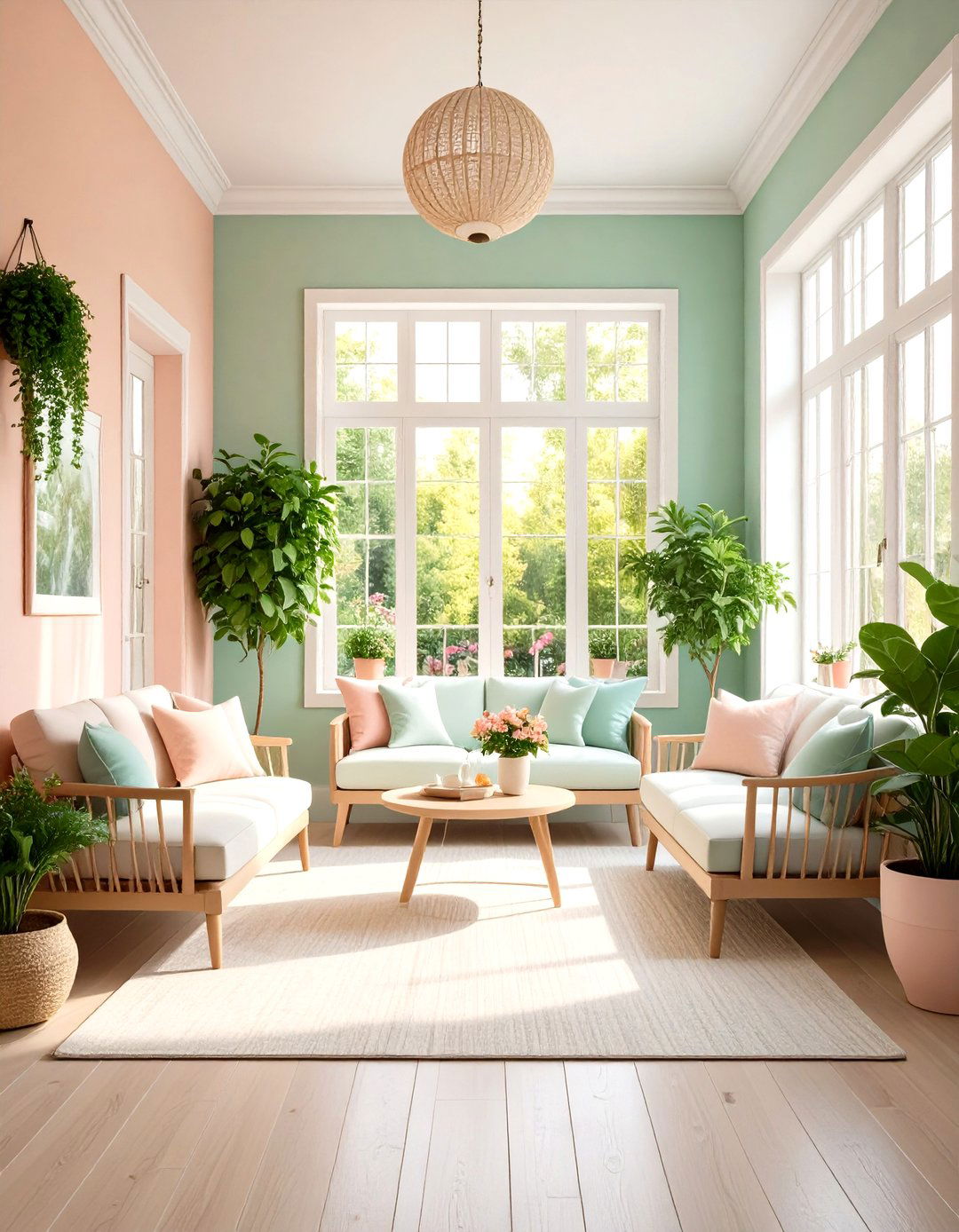
Swap stark contrasts for whisper-soft sage, blush, or buttercream accents—hues that complement sun-washed linen and weathered timber. Paint window stools a dusty robin’s-egg blue, or slip a pale peach cushion onto the porch swing to freshen neutrals without overwhelming the eye. Because pastels contain more white than saturation, they resist fading and reflect light, amplifying the sunroom’s natural glow.
15. Built-In Window Bench Maximizes Seating
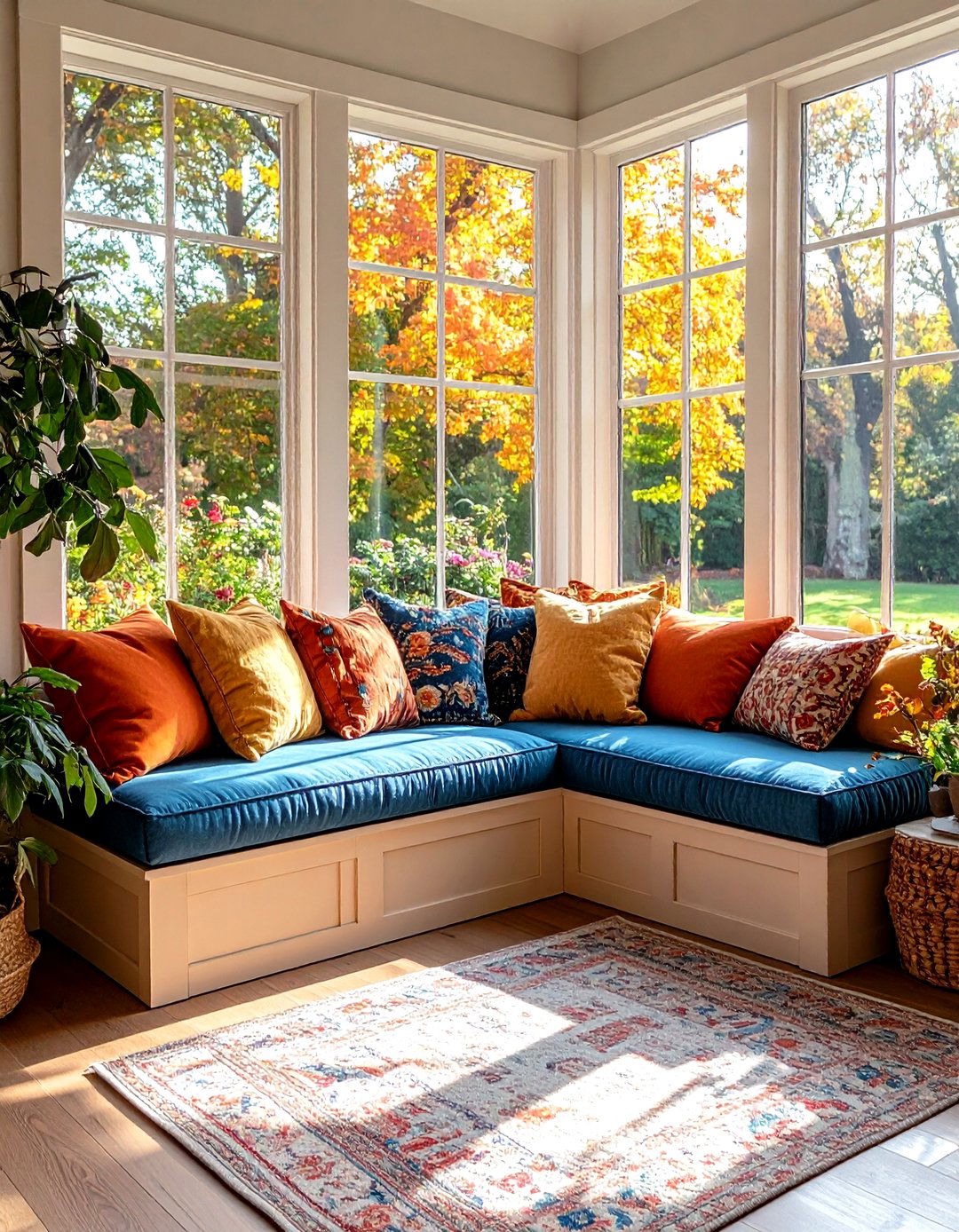
A wall-to-wall bench beneath south-facing panes delivers hidden storage and the best perch in the house. Construct the base from plywood, add toe-kick vents if HVAC runs beneath, and top with a high-density foam cushion wrapped in performance fabric. Hinged lids keep board games, throws, and pet beds neatly stashed. For visual rhythm, align beadboard fronts with adjacent window mullions, echoing the sunroom’s vertical lines.
16. Farmhouse-Industrial Blend With Metal Accents
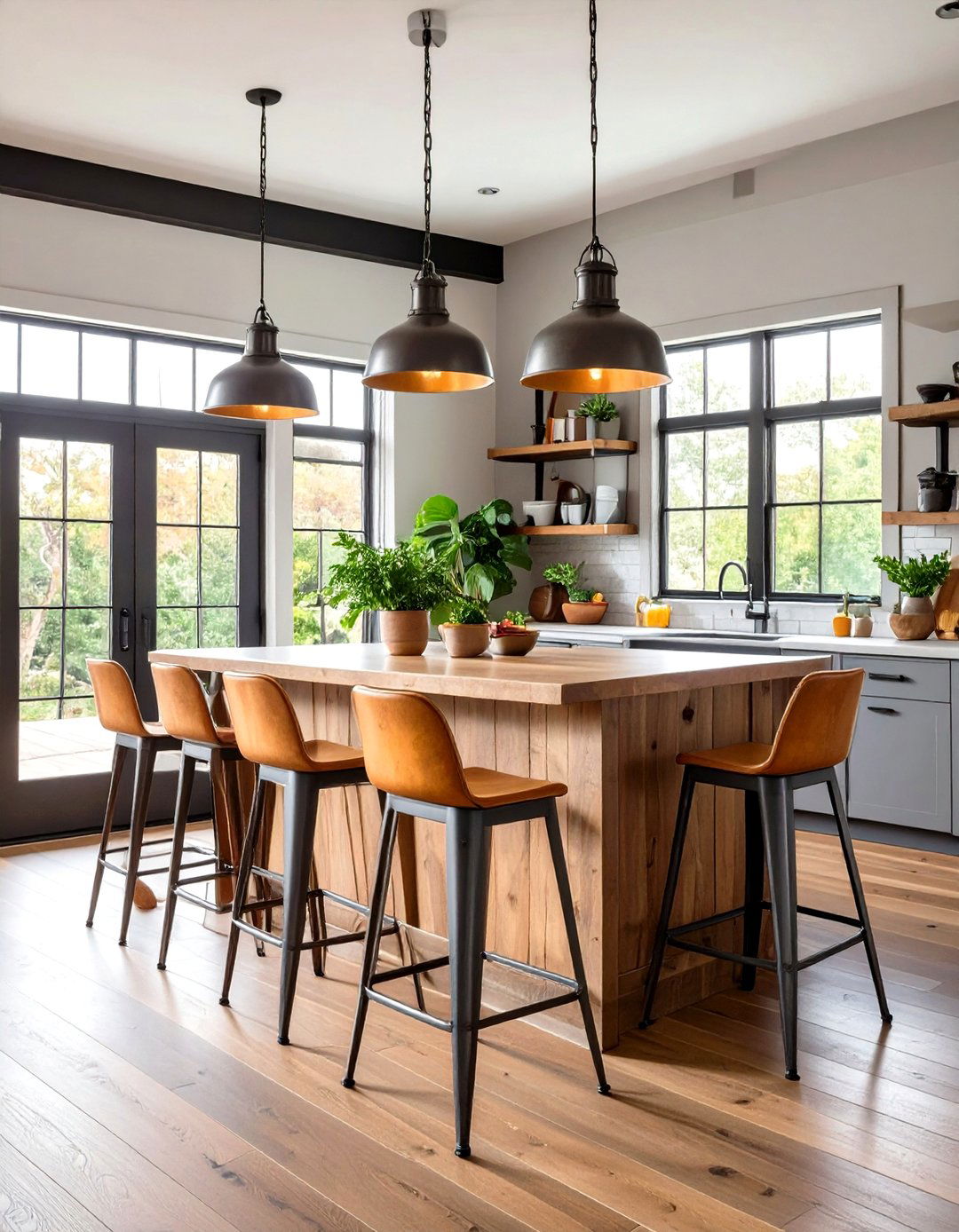
Introduce subtle industrial notes—raw-steel stools, a pulley-style pendant—against rustic backdrops for a curated, less “theme-park” farmhouse vibe. The secret lies in repeating shapes: a metal-rim coffee table mirrors lighting cages, while matte-black cabinet hardware ties back to window frames. Mixed-metal harmony established earlier ensures these touches feel deliberate, not jarring, reinforcing the room’s lived-in authenticity.
17. Seasonal Swap-Out Décor Keeps the Look Fresh
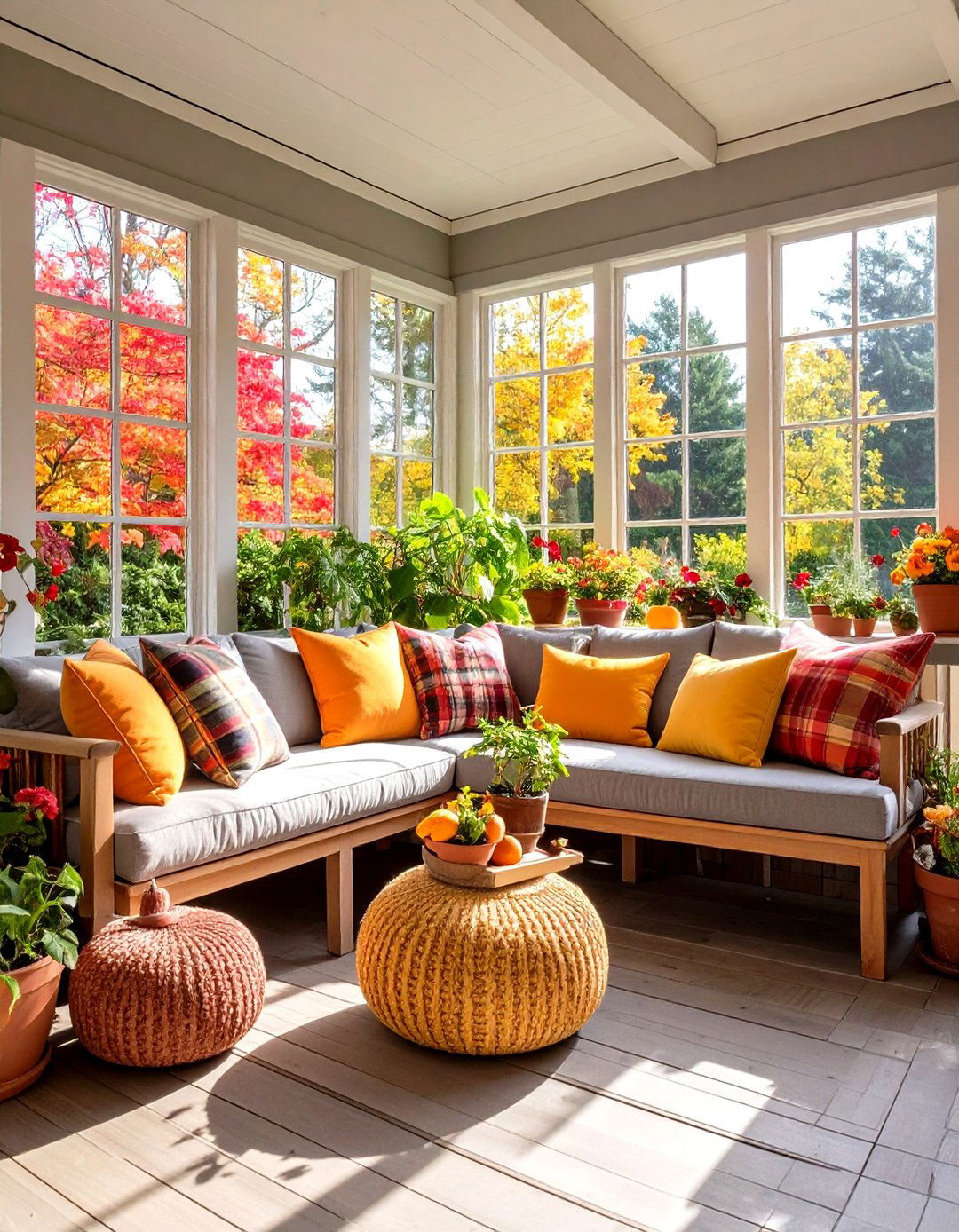
Because a sunroom acts as a visual extension of the outdoors, adapting accessories to the calendar keeps energy high. In spring, trade chunky knit throws for gauzy linen, replace cedar cones with hyacinths, and roll up wool rugs. Autumn invites plaid pillows and dried wheat bundles. Store off-season accents in under-bench bins labeled by month to streamline changeovers and preserve that uncluttered farmhouse ambiance.
18. Vintage Area Rugs Warm Up Hard Floors
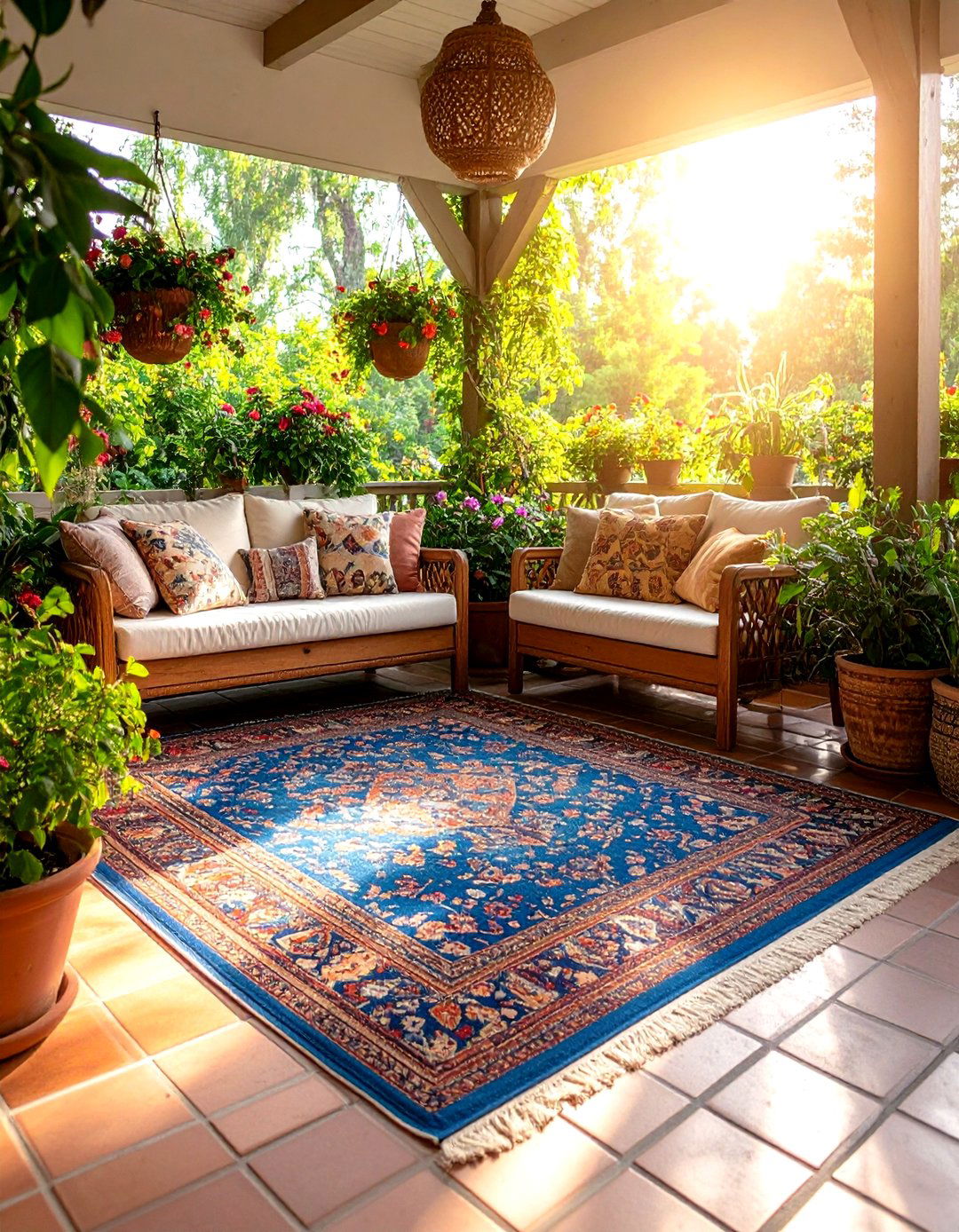
A mid-century Anatolian runner or faded Persian over brick or tile softens acoustics and introduces heirloom credibility. Prioritize low-pile weaves that allow doors to glide easily and that won’t trap sand tracked from the garden. Rotating rugs 180° each season evens sun exposure, prolonging life. A rug pad rated for radiant-heat floors prevents slippage and cushions standing joints during after-noon potting sessions.
19. Hanging Rattan Swing for Playful Relaxation

Suspend a nest-style rattan chair from a ceiling joist using a rated porch-swing kit and stainless hardware to avoid corrosion in humid air. The gentle sway encourages meditation or storytelling, and kids adore retreating into the pod-like seat. Keep clearance of at least 30 inches around the swing, and add a washable lumbar pillow in ticking stripe to reinforce the farmhouse narrative.
20. Climate-Smart Insulation Tricks for Year-Round Use
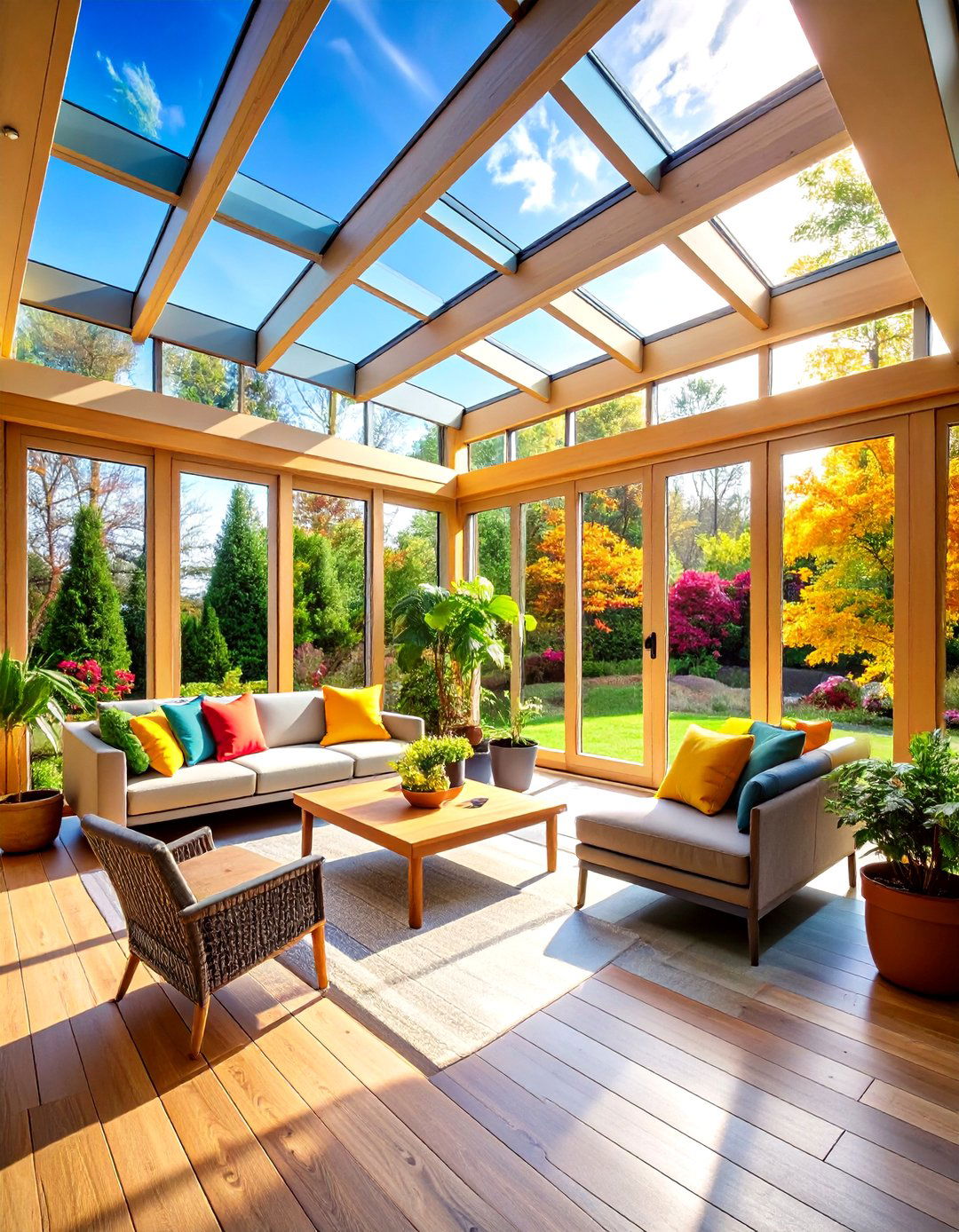
Even prettiest sunrooms falter without comfort control. Spray-foam insulating beneath decking, low-E glazing, and an inconspicuous mini-split HVAC unit maintain 18-22 °C all year, ideal for both herbs and humans. Consider ceramic film on older windows to block 50 % of solar gain without tinting views. A tabletop hygrometer lets you dial humidity for plants—add a small humidifier in winter or open clerestory vents on muggy July afternoons.
Conclusion:
A thoughtfully designed farmhouse sunroom marries honest materials, flexible openings, and cozy layers to craft a refuge that shifts effortlessly from seed-starting station to fireside lounge. By blending structural character—wood beams, brick floors, barn doors—with adaptable décor such as neutral textiles and movable wicker, you create a timeless space that welcomes every season in style. Keep the room’s energy alive by rotating accents, nurturing an herb corner, and fine-tuning climate controls, and your sunlit retreat will continue to feel as fresh and inviting as the day it was built.


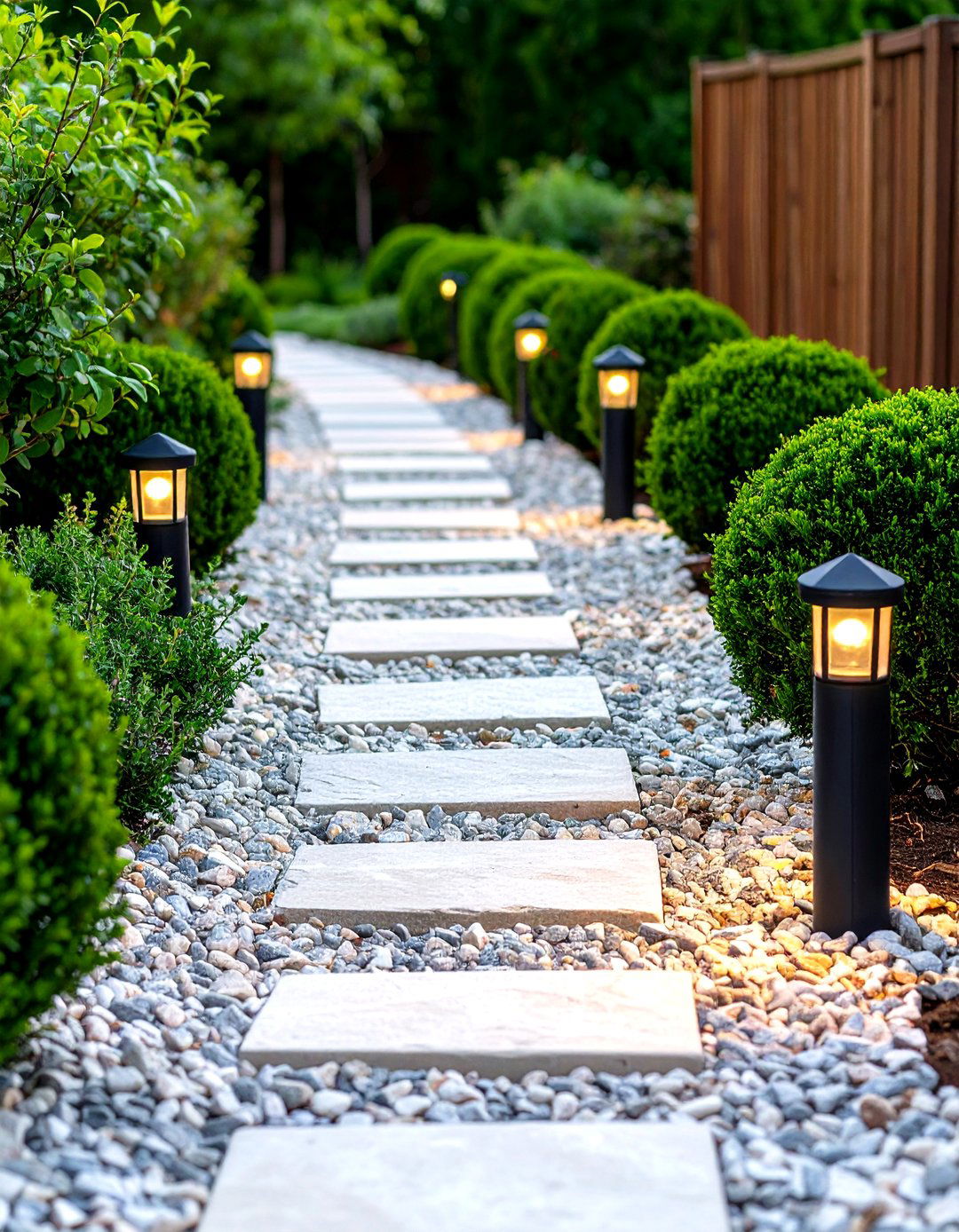
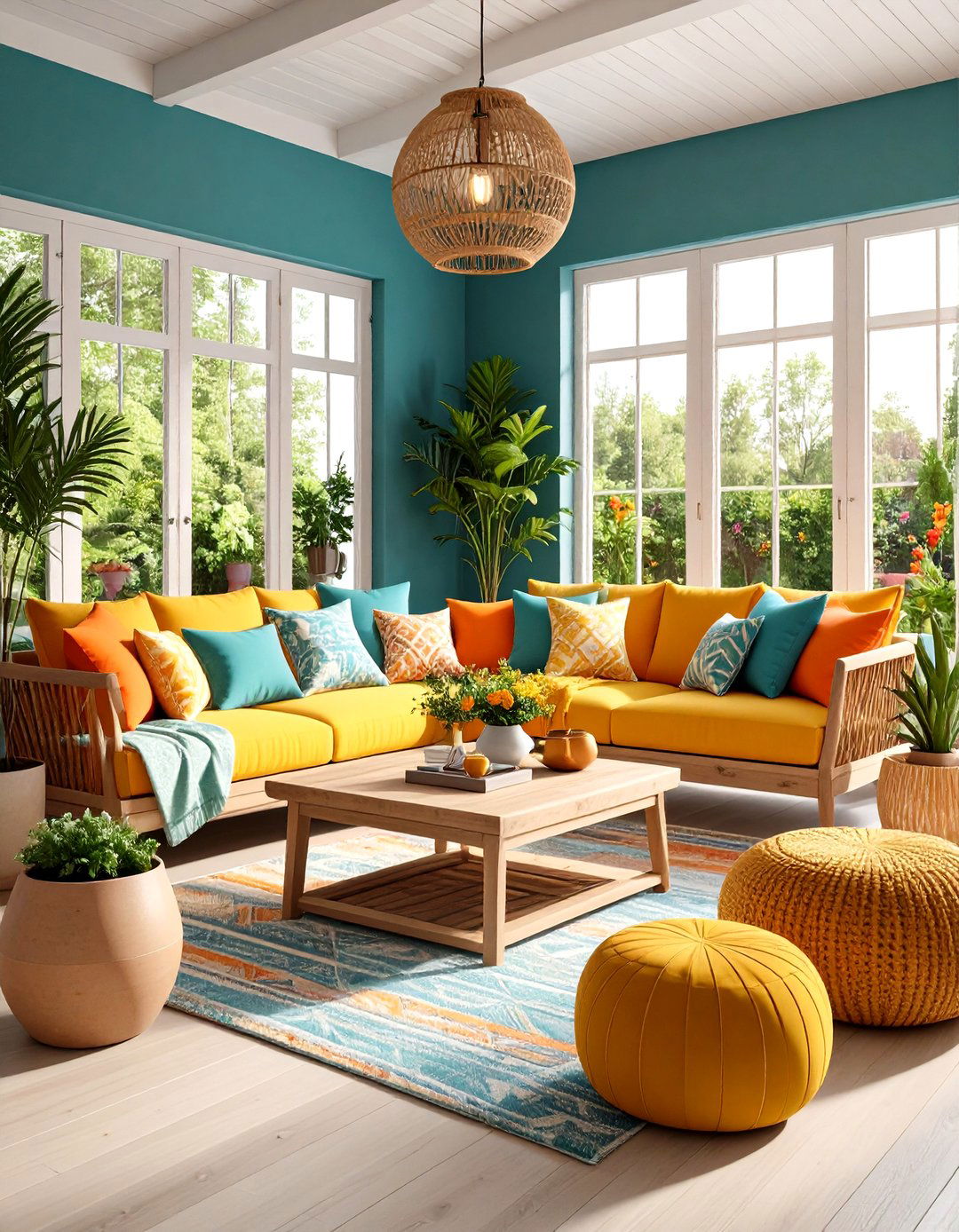

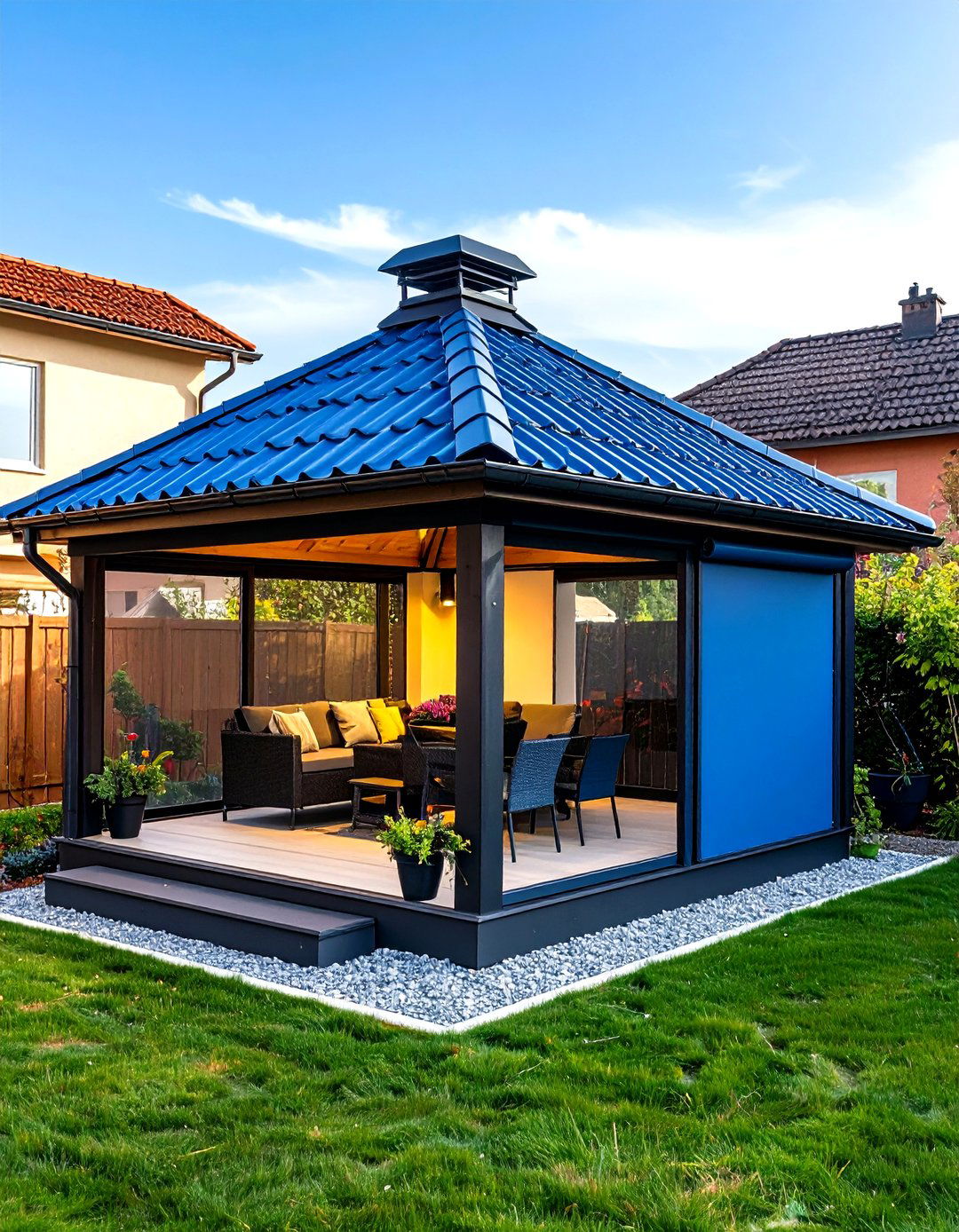

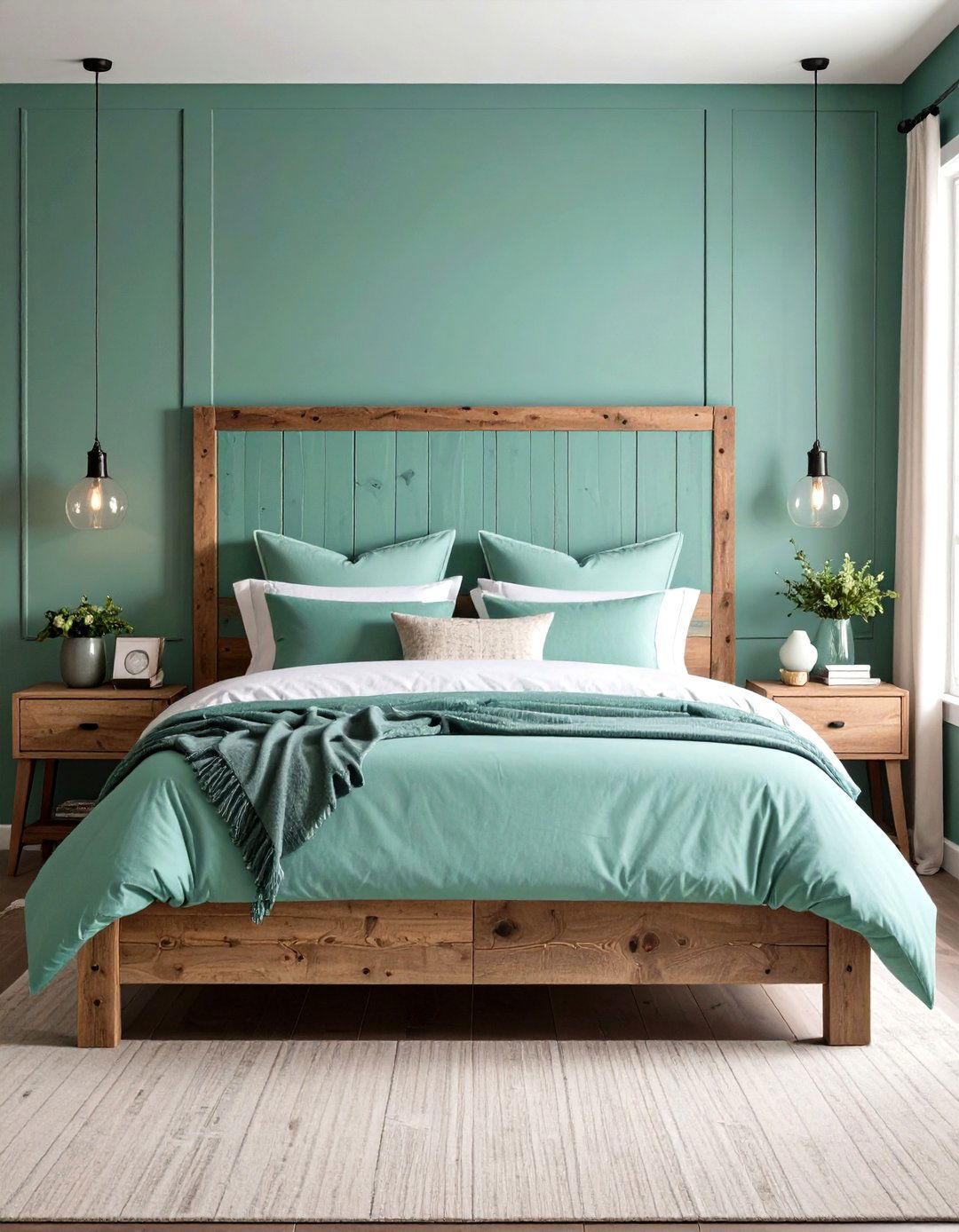

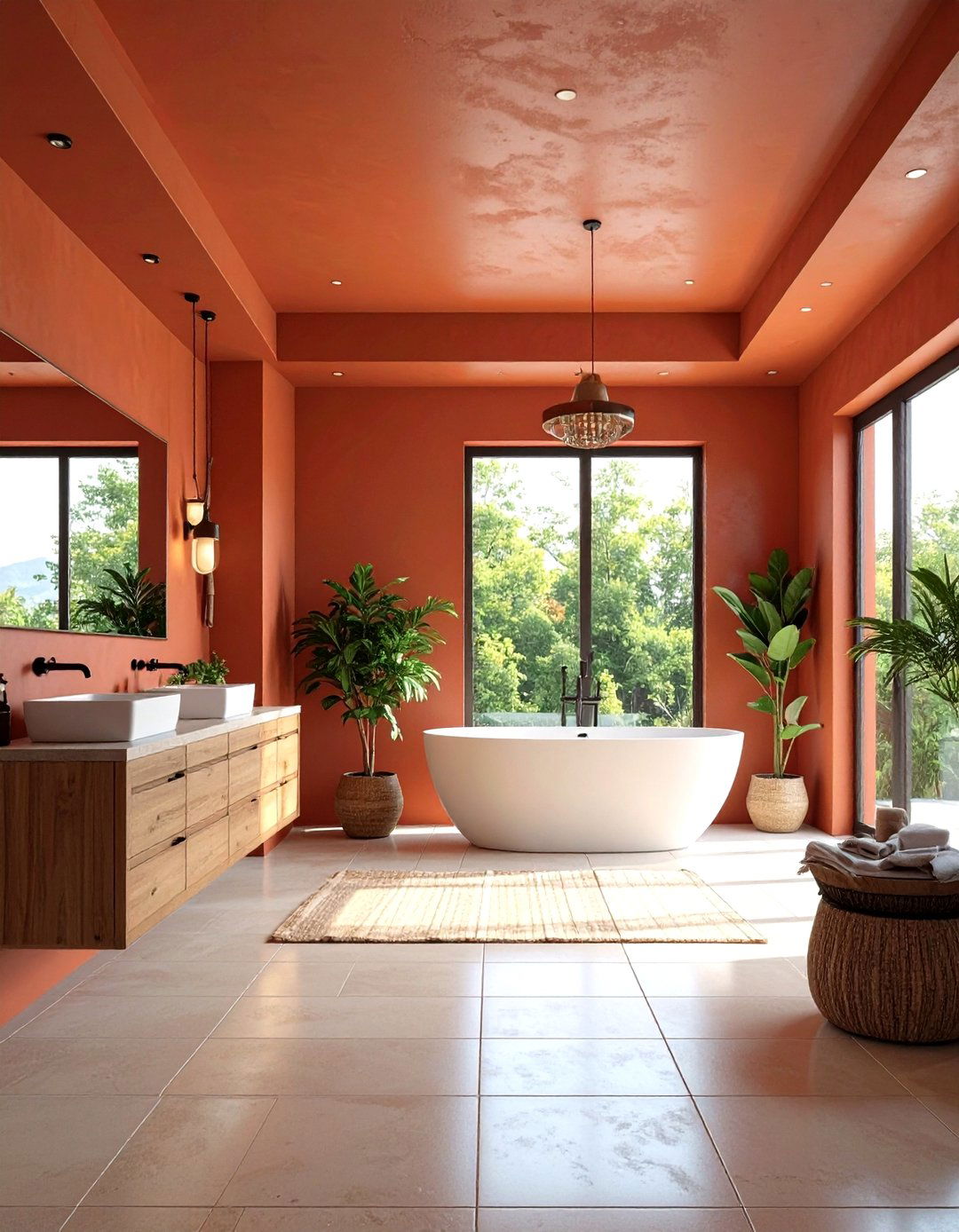

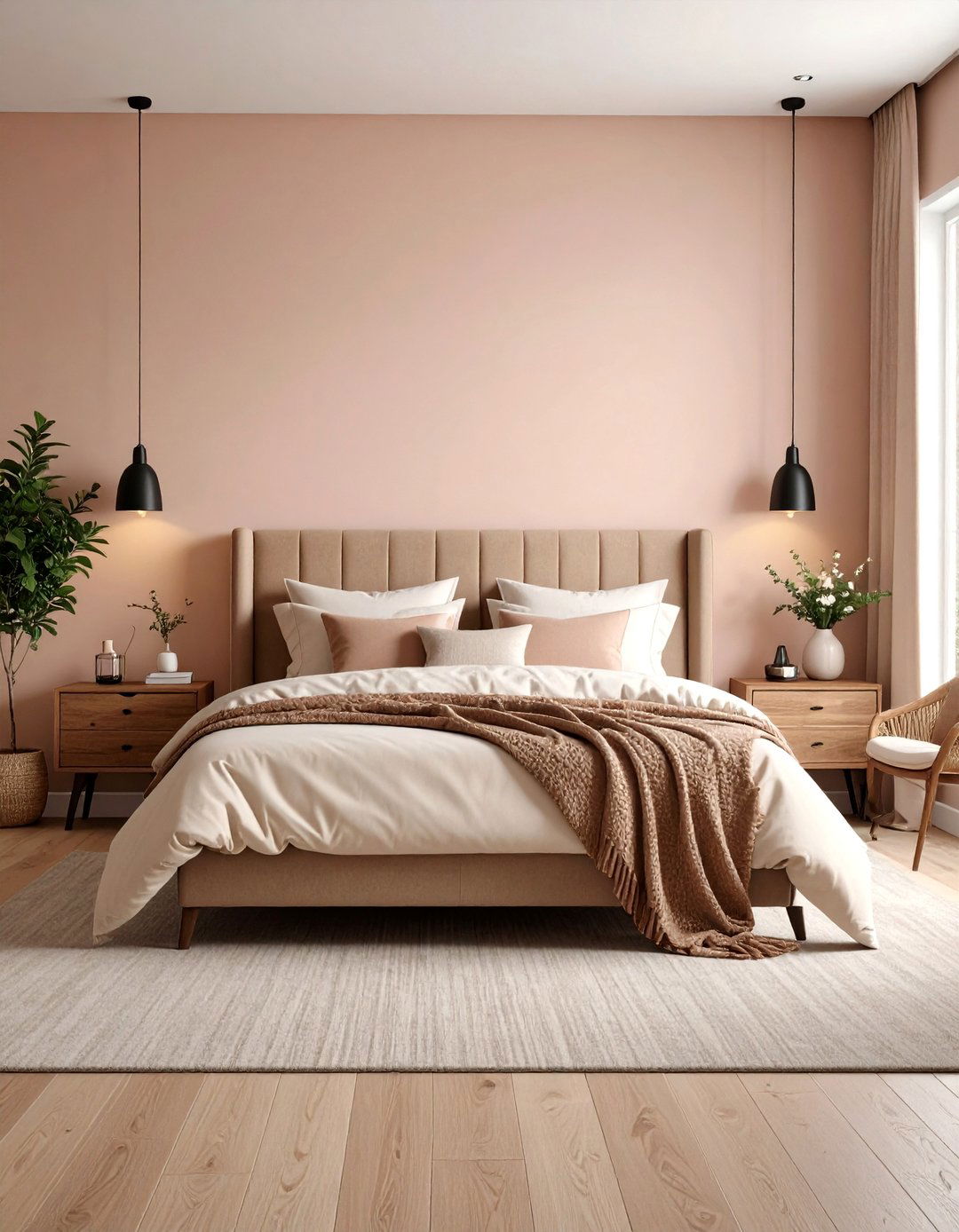
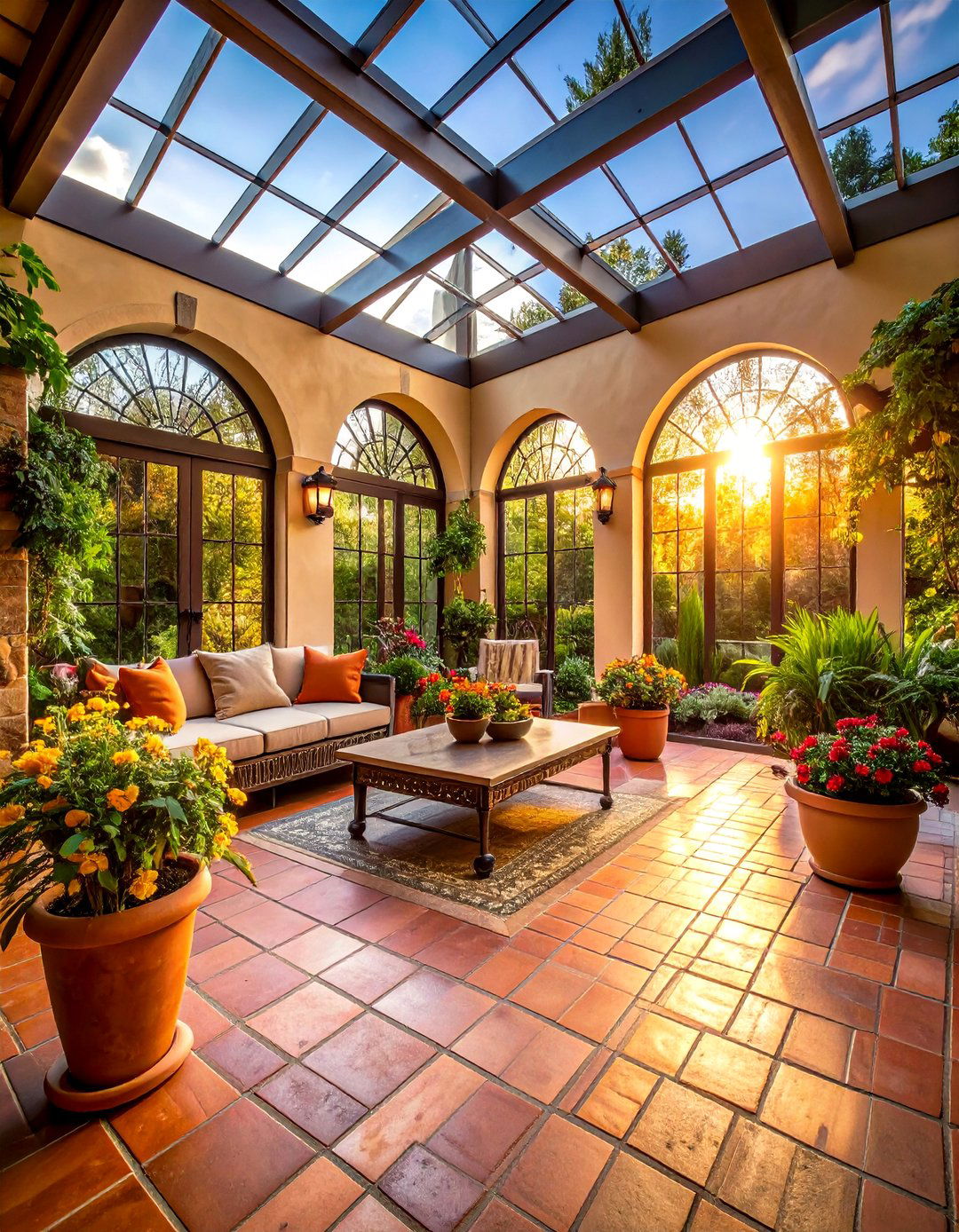
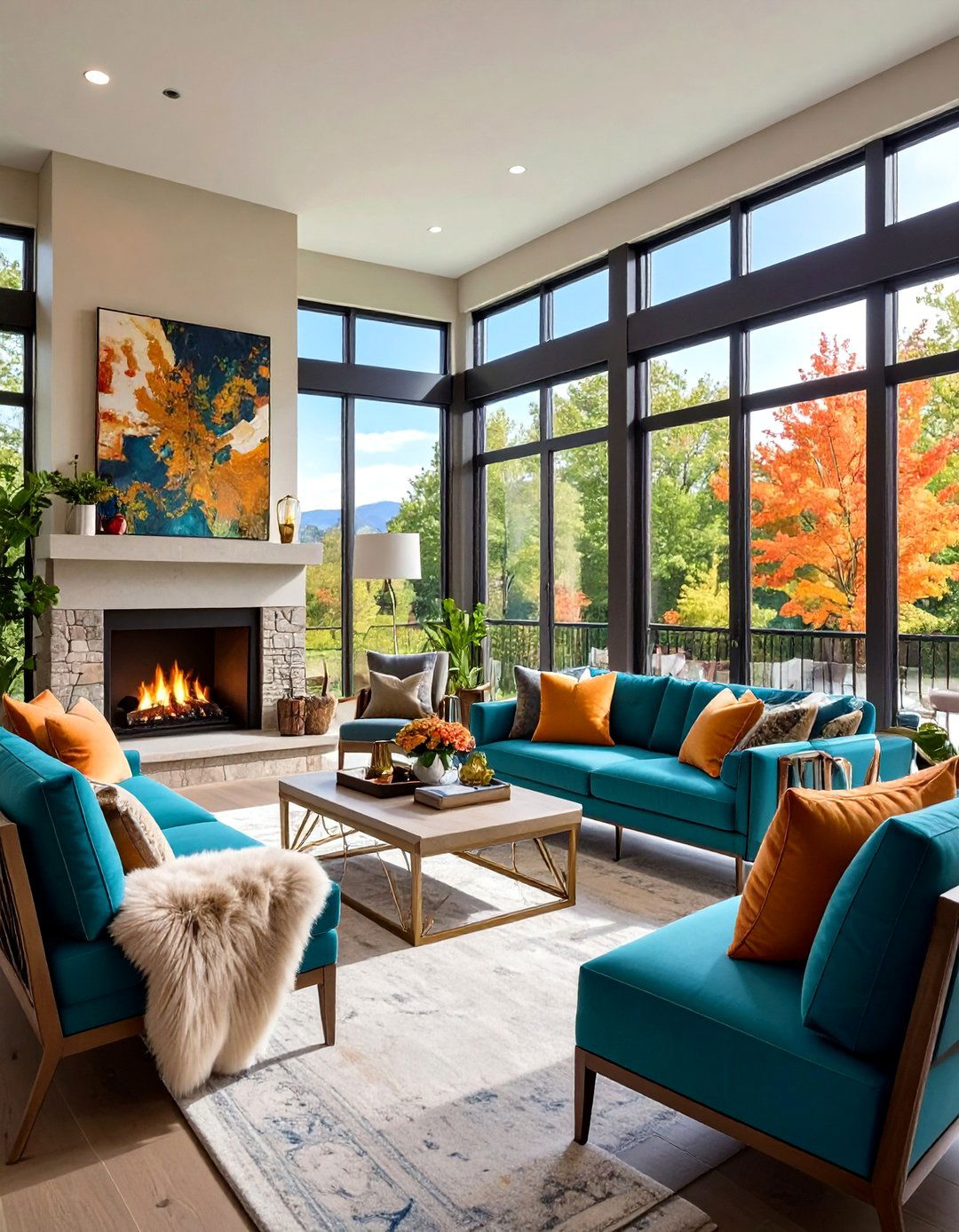

Leave a Reply